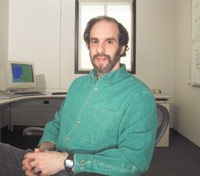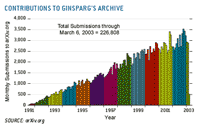 May 2003 issue May 2003 issue |
 Image: FOREST McMULLIN PAUL GINSPARG: THE ACTIVE ARCHIVIST
|
That same independent streak manifested itself 13 years later when the former student, Paul Ginsparg, took a few hours to program a NeXT computer at Los Alamos National Laboratory. The program directed the computer to accept prepublication copies of physics papers automatically and to send out e-mail abstracts of the papers. The full text of the preprint could then be retrieved by querying the computer. Within weeks after the server (then called xxx.lanl.gov) became active in 1991, communication within the high-energy-physics community underwent a transformation. The preprints, which had been available to only an elite few, could now be picked over by anyone instantaneously, whether in Cambridge, Kraków or Calcutta.
The server radically democratized some of the most esoteric pursuits in contemporary science and changed lives--scientists in eastern Europe, the Middle East, South Asia and Latin America suddenly became contributors to or critics of the latest paper on "exact black-string solutions in three dimensions." A self-taught Czech string theorist even won a U.S. graduate scholarship after posting several papers. The importance of Ginsparg's achievement was recognized last year when the researcher won a $500,000 MacArthur fellowship.
Physics, computers and communications have constituted parallel themes throughout Ginsparg's life. The son of a mechanical engineer, Ginsparg built and operated ham radios as a youth in Syosset, Long Island, and later became a Harvard classmate of future Microsoft magnates Bill Gates and Steve Ballmer. His graduate thesis at Cornell dealt in part with the incorporation of fermions, a type of subatomic particle, into lattice theory, a computational means of attacking difficult challenges in high-energy physics. Moving on to a career as a fellow and later a junior professor at Harvard, Ginsparg often found himself enlisted to concoct hastily fashioned software programs that would solve, say, a problem in superstring theory--in which all the fundamental forces, including gravity, are explained in terms of vibrating strings. "The average physicist wasn't into doing this--it was just so alien to them," the 47-year-old Ginsparg muses, his shoeless feet propped on a chair in his office at the Information Sciences building at Cornell.

Image: JOHNNY JOHNSON CONTRIBUTIONS TO GINSPARG'S ARCHIVE Click for full-size image |
Ginsparg was accomplished enough as a physicist to have a subatomic particle, the Ginsparg-Wilson fermion, named after him and his thesis adviser, 1982 Nobelist Kenneth G. Wilson. But he had not, in Harvard's view, initiated a significant new field of research, a prerequisite for tenure. The university's denial was a disappointment, but based on what happened later, he says, "it was the best thing that could possibly have happened."
In 1990, with the fall of the Berlin Wall, Los Alamos National Laboratory began embracing new missions. It extended an open invitation to Ginsparg, and he accepted. It was a logical place for a theoretical physicist with a passion for mountain climbing and cycling. The preprint server came about serendipitously, as Ginsparg's spur-of-the-moment reaction to a colleague's complaint about his electronic mailbox not accepting new messages when it became overloaded with e-mail transmittals of preprints. When the e-print archive was born, in 1991, it was intended to hold papers for only three months. The project became such an instant success that it was turned into a permanent archive--a meticulous record of everything that has occurred in high-energy physics since then. The pace of interaction in the high-energy community--and other disciplines that were added later, such as astrophysics and condensed-matter studies--quickened appreciably. "String theory made unprecedented progress over the last 10 years perhaps due more to Ginsparg than any other individual," says Harvard physicist Andrew Strominger.
Early on, the physics publishing establishment did not know what to make of the archive. "I felt like a visitor from the future showing 19th-century mathematicians the power of the pocket calculator," Ginsparg remarks. At the time, the American Physical Society (APS) had yet to consolidate plans for bringing its journals online, and officials worried about copyright issues and a loss in subscribers. But after Martin Blume took over as editor in chief of the APS six years ago, the tension subsided. Blume paid a visit to Ginsparg at Los Alamos to, as he put it, "make peace." He scrapped APS's own preprint archive and changed copyright terms to allow posting of society-published articles in the archive.
Ginsparg's ideas are now actively solicited by the APS and other organizations, such as PubMed Central, a free archive of life sciences journals. One part of his initial vision that remains unfulfilled is to do away entirely with physics print journals by instituting online peer review of papers submitted to the server. Ginsparg proposes a two-tiered system: all papers submitted to the archive would get cursory scrutiny, but only the most valued findings would go on to receive full peer review.
The biology community, which has been slow to adopt electronic preprints, may actually pioneer the next wave of online publishing. The Public Library of Science, a nonprofit based in San Francisco, will create free access to peer-reviewed electronic biology and medicine journals as an alternative to subscription-based science publications.
The originally welcoming atmosphere at Los Alamos mutated as the 1990s wore on. Nonweapons projects started getting short shrift, and the Wen Ho Lee scandal fostered a paranoia inimical to the open exchange of ideas that the archive embodies. Disenchanted, Ginsparg accepted a joint professorship in information sciences and physics at Cornell in 2001. He brought with him the archive (now called arXiv.org), delegating its maintenance to the university library.
The move to Cornell has afforded Ginsparg an opportunity to return to physics. He is also exploring techniques to facilitate the navigation of the archive for relevant papers but has given up day-to-day responsibility for the repository with a sense of relief: "I think I have overstayed the 15 minutes that Andy Warhol allotted me by a decade." The combination of the MacArthur grant and tenure should permit him to do what he loves best: calculations and problem solving that no one else has touched, whether in physics or computer science.
Reproduction in whole or in part without permission is prohibited.